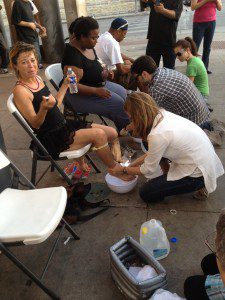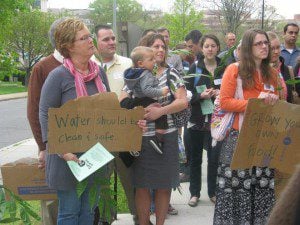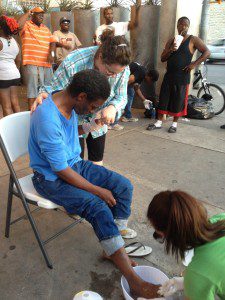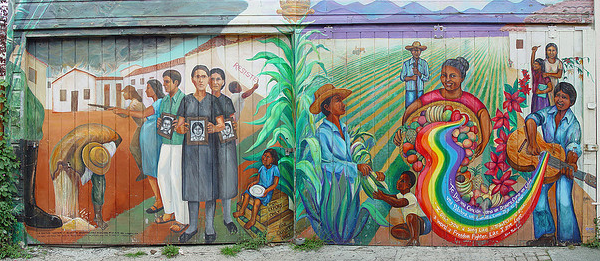Last week, I posted an essay on Protesting Holy Week.
A lot of people read it. A lot more than usual.
Some folks loved it. Some folks hated it. Some folks were in-between.
Some folks lived it. And are living it today.
So, I thought I’d take a moment, first to say thanks to everyone who read, shared, debated and thought about the essay. And secondly, to highlight all those folks who shared with me how they were protesting Holy Week. Some folks said they were inspired by the post; others had been planning their actions for months or weeks.
What strikes me is how similar many of these stories are to the en vogue practice in Episcopal churches of Ashes to Go on Ash Wednesday. Almost universally, priests who take their ritual and faith into the streets report that the rituals themselves became more meaningful and more connected to what it means to be both a Christian and a priest.
In many ways, however, Ashes to Go is a simple offering that requires little conviction or courage. What follows are more costly examples as folk protested Holy Week, or if that phrase bothers you, took Holy Week to the Streets. They are just a handful of examples. I am sure there are more, like the commenter on the post that said they turned over tables during their Palm Sunday service and then processed to an Occupy general assembly! In addition, I heard from congregations that have been protesting Holy Week for decades.
In any event, as these stories, tweets, e-mails and links rolled in, I found myself echoing the women at the empty tomb — “I have seen the Lord.” I found myself echoing the liturgy on Easter — “Christ has risen indeed. Alleluia.”
If you know of other examples post a link in the comments!
After reading the original essay, Jillian charged ahead and decided to host a footwashing on Maundy Thursday at a shelter near her church. Her e-mail about her experience moved me deeply. She said that, up until the last moment, she had no idea whether she would be joined by others or if she’d be flying solo. Turns out, she had companions join her.
When they got to the shelter another group was there and had provided dinner and music.
Neither group knew about the other, and both had planned to wash feet. Only the other group forgot their supplies. Jillian’s church had plenty to share. And then, one of the other group’s members said something that pretty much sums up succinctly what that first suggestion to take Holy Week into the streets was all about.

“We thought you would all be in church on Maundy Thursday,” one of them said.
But everything went off so well, that it was like it was all part of the plan. Someone in the group commented,
“It’s like the Holy Spirit threw a block party and we were all invited.”
That folks is church.
_____
From my friend Anton of Alterna:
Anton is the organizer of alternative, intentional community of Christians in La Grange, Ga. He also happens to be my spouse’s former youth pastor. I was introduced to him and his work, however, through a reader and Internet friend of mine, Robin from Maryland. The Internet is weird.
Anton has been organizing Holy Week pilgrimages for immigration justice for years, and when we connected a few months ago, he invited me to join him. It was a moving experience. As a postulant for the priesthood, I sometimes have experienced a disconnect from the Table where we distribute the Bread of Heaven to outstretched palms and where the Body of Christ lives. But things changed the day I joined them as the march and distributed dollops of sunscreen to outstretched palms. I could not help smiling at the Communion we experienced in that small act and the warped reflection of what happens at Sunday Eucharists.
 I spent most the march in conversation with the wonderfully wise and generous Jean. When we finished, sweaty and tired, at a Catholic church, our prayers and songs were tied not just to our ethical and philosophical convictions, but directly to our actions. By the time we got the Church building, it was clear that we had been having church for hours with our feet, our prayers, our songs and our conversations on the roadside.
I spent most the march in conversation with the wonderfully wise and generous Jean. When we finished, sweaty and tired, at a Catholic church, our prayers and songs were tied not just to our ethical and philosophical convictions, but directly to our actions. By the time we got the Church building, it was clear that we had been having church for hours with our feet, our prayers, our songs and our conversations on the roadside.
_______
 Church of the Pilgrims in D.C., got creative and instead of taking protest to the streets, they infused protest into the Palm Sunday processional. The congregation drew up some protest signs and process from the streets into the church with their protest signs. In some ways, bringing the protest into the center of worship might be more radical than taking protest into the streets. I thought it was a wonderful liturgical move. But I can’t find the pictures that were sent to me.
Church of the Pilgrims in D.C., got creative and instead of taking protest to the streets, they infused protest into the Palm Sunday processional. The congregation drew up some protest signs and process from the streets into the church with their protest signs. In some ways, bringing the protest into the center of worship might be more radical than taking protest into the streets. I thought it was a wonderful liturgical move. But I can’t find the pictures that were sent to me. When I do, I’ll update the post. Found it.
________
And this post would not be complete without a nod to the Protest Chaplains of Occupy Wall Street fame. I came across this link on Twitter, so I don’t think it has much to do with my little post last week, but I wanted to acknowledge it anyway. The Protest Chaplains re-created the Stations of the Cross throughout Boston and infused each station with messages of justice and liberation.












